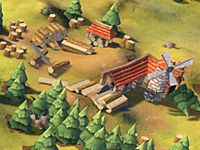Lonecat Nekophrodite
Deity
- Joined
- Jan 10, 2019
- Messages
- 2,781
Are Water Mill (available with The Wheel, Buildable in city center that is located by rivers, +1 or 2 production and food) and Windmill (as Medieval Lumber Mill TI) correctly represented in game?.
1. Outside gristling, water pumping and gunpowder manufacturing. Are there wind powered lumber mill as graphically represented in game?


2. Water wheels are main prime movers of pre-steam industry, everything that has to be produced en mass needs the assistances of water wheels, outside gristlings, metalworkings required waterwheels for their furnaces, rollers, and continious action forging hammers. Lumber mills are (I think) more correctly powered by water wheels before steam engine came to use, later gunpowder makers need continious mixers to do the job, and (possibly in the Enlightenment Era) cannon foundries use water powered drills to bore gun holes (particularly with Moritz came to France and worked for de Vallierre and Gibreauvalle ).. just a glimpse of examples. and this explains why Early Industrial Centers of any given empires are all located by rivers (and usually deep inland where stream runs strong). too bad Industrial District earns no benefits of river adjacency AT ALL! (and no Water Wheels for such district available regardless of acutal history uses of this thing). Can't Water Wheels be an upgrade to the existing workshops?
This is what Industrial District looks like in Medieval Era 
3. And can windmill serves the functions in Item 2 too?
1. Outside gristling, water pumping and gunpowder manufacturing. Are there wind powered lumber mill as graphically represented in game?


2. Water wheels are main prime movers of pre-steam industry, everything that has to be produced en mass needs the assistances of water wheels, outside gristlings, metalworkings required waterwheels for their furnaces, rollers, and continious action forging hammers. Lumber mills are (I think) more correctly powered by water wheels before steam engine came to use, later gunpowder makers need continious mixers to do the job, and (possibly in the Enlightenment Era) cannon foundries use water powered drills to bore gun holes (particularly with Moritz came to France and worked for de Vallierre and Gibreauvalle ).. just a glimpse of examples. and this explains why Early Industrial Centers of any given empires are all located by rivers (and usually deep inland where stream runs strong). too bad Industrial District earns no benefits of river adjacency AT ALL! (and no Water Wheels for such district available regardless of acutal history uses of this thing). Can't Water Wheels be an upgrade to the existing workshops?

3. And can windmill serves the functions in Item 2 too?
